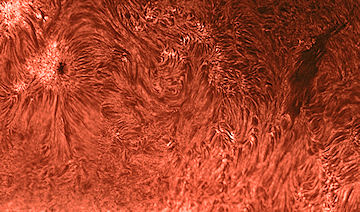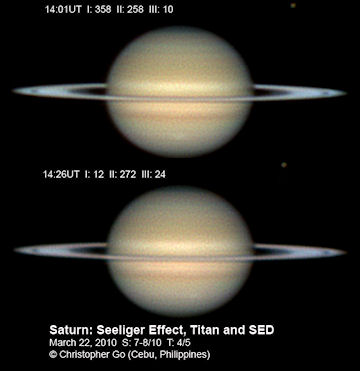NEW AND IMPROVED: Turn your iPhone or iPod Touch into a field-tested global satellite tracker. The Satellite Flybys app now works in all countries. | | | EMERGING SUNSPOT: A new and fairly large sunspot is emerging over the sun's northeastern limb. "It appears to be very active," says Didier Favre who sends this picture from Brétigny-sur-Orge, France. readers with solar telescopes are encouraged to monitor developments. STARSCAPE: It's been a quiet day on the sun. But even a quiet day on a raging stellar inferno can take your breath away. Click on the image below to view a hundred billion sq. kilometers of local starscape: 
Roger Marcon recorded this magnificent view on March 22nd from his backyard observatory in Campinas, Brazil. "I couldn't fit the whole thing in a single exposure," he says. "To cover the expanse, which includes sunspot 1056 on the left and a bushy magnetic filament on the right, I took ten pictures and stitched them together." His high-tech equipment: an off-the-shelf Coronado SolarMax40 filter and a 200mm (~8 inch) refracting telescope. Forecasters of solar activity say tomorrow should be quiet, too. Sounds like a good day to photograph the sun. SATURN'S RINGS: This week Saturn is "at opposition." That's astronomy jargon for "Saturn and the sun are on opposite sides of the sky." Saturn rises at sunset and soars overhead at midnight, up all night. This arrangement has a striking effect on Saturn's rings. It makes them bright. Amateur astronomer Christopher Go of the Philippines photographed the phenomenon last night: 
Photos taken through an 11-inch Celestron telescope
"The rings are very bright due to the Seeliger Effect," says Go. Also known as the "opposition effect," the Seeliger effect has been observed on the Moon, Earth and Mars. It happens when sunlit objects (such as the icy particles that make up Saturn's rings) hide their own shadows. A process called coherent backscattering may also contribute to the extra luminosity. Whatever the details may be, the net result is beautiful. "The Seeliger Effect should be operative for a few more days," says Go. Readers with backyard telescopes should take a look: sky map. more images: from Torsten Hansen of Boos, Germany; from Efrain Morales Rivera of Aguadilla, Puerto Rico;
UPDATED: March Northern Lights Gallery
[previous Marches: 2009, 2008, 2007, 2006, 2005, 2004, 2003] | 
